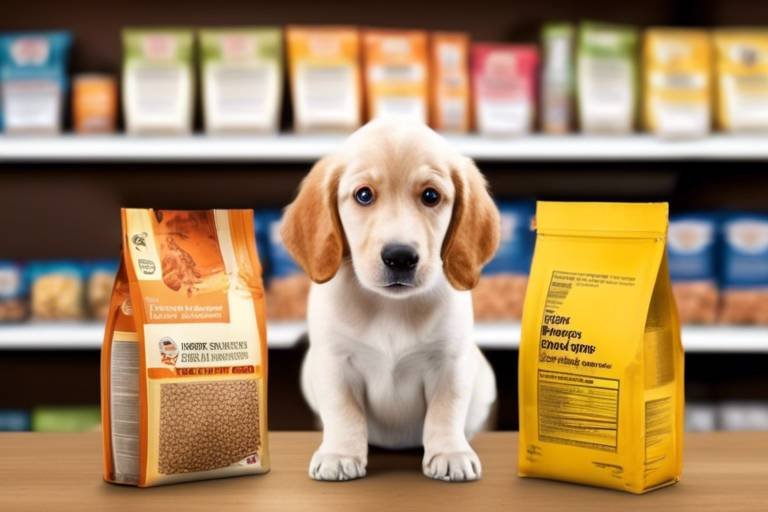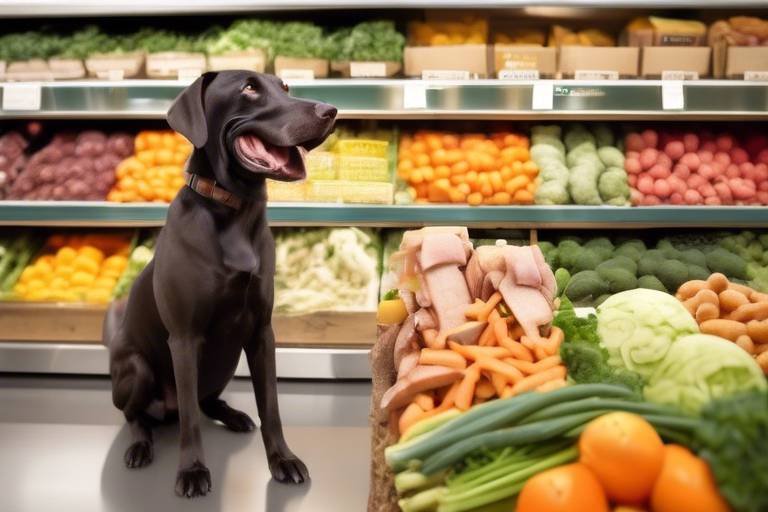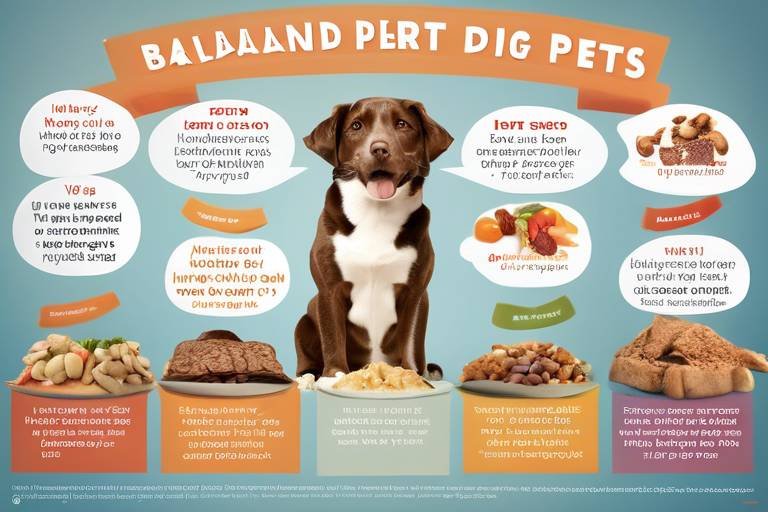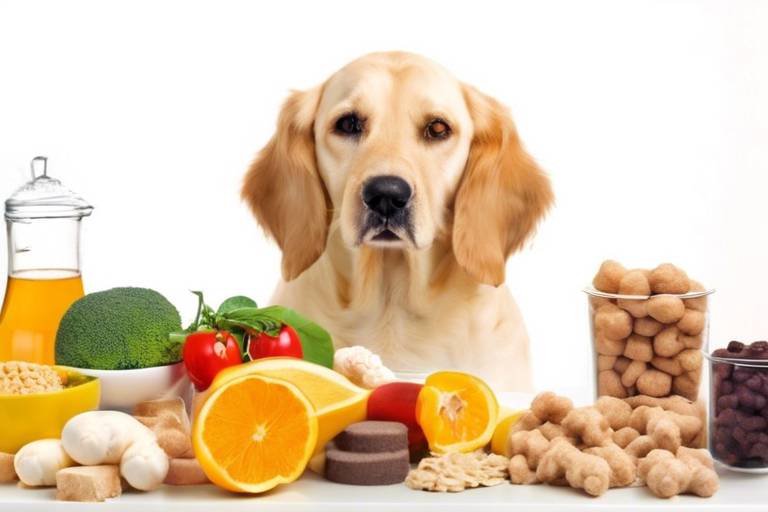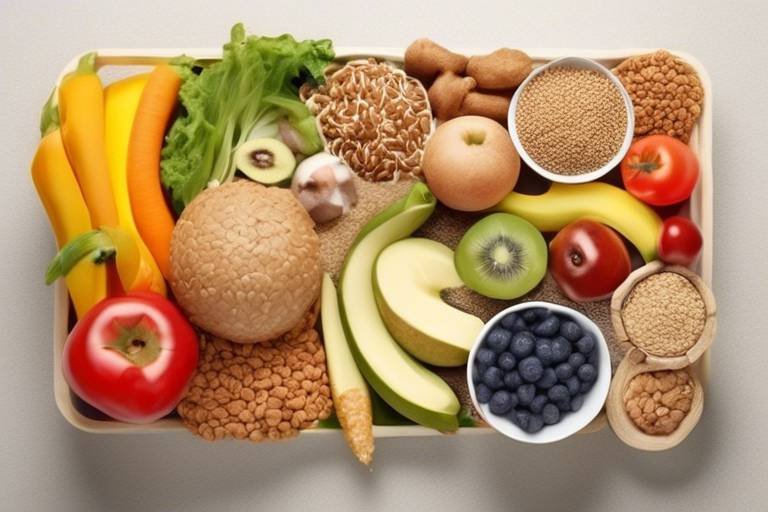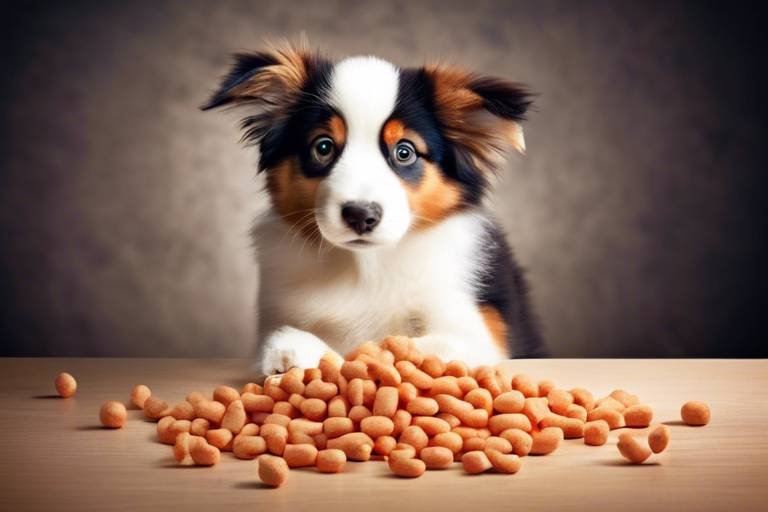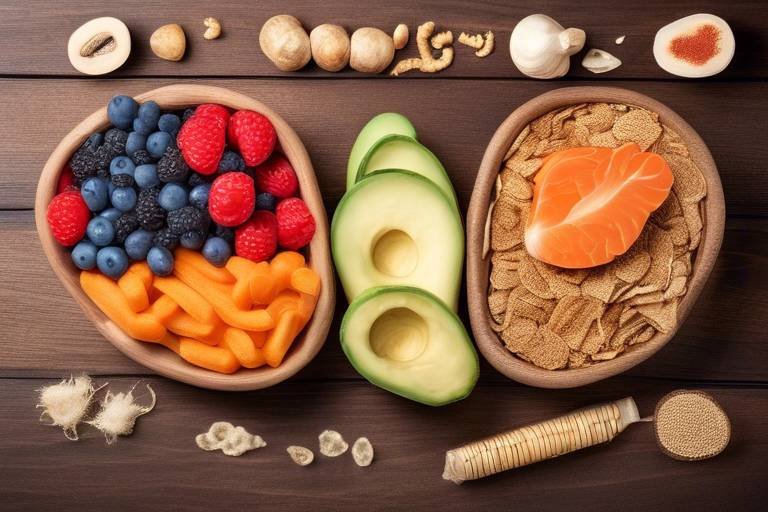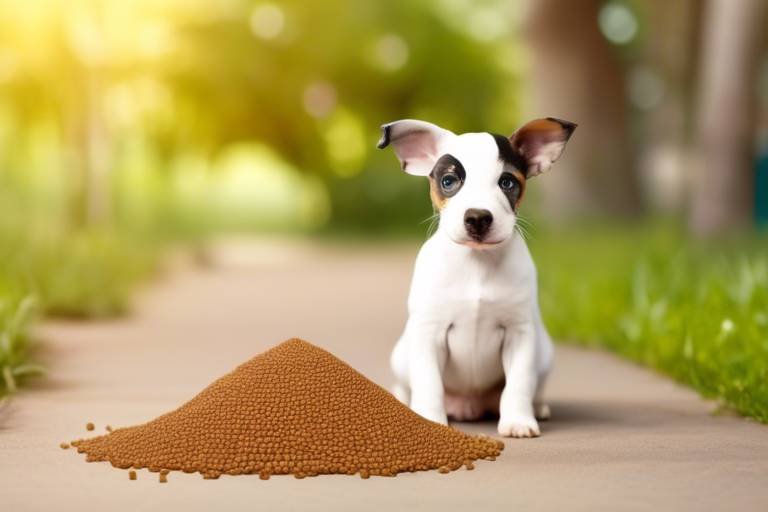How to Read Ingredient Lists on Pet Food Packages
Understanding pet food ingredient lists is crucial for making informed choices about your pet's nutrition. With so many options on the market, it can be overwhelming to navigate through the myriad of labels and claims. But fear not! This article will guide you through the essential components of pet food labels, the terminology you need to know, and tips for selecting the best food for your furry friend. By the end of this read, you'll have the knowledge to make choices that promote your pet's health and happiness.
Pet food labels contain essential information that can influence your purchasing decisions. When you pick up a bag of kibble or a can of wet food, you might notice a plethora of information, from feeding guidelines to nutritional claims. Familiarizing yourself with label terminology will help you decipher what’s truly in your pet's food. For instance, the ingredient list is typically arranged in descending order by weight, meaning the first few ingredients are the primary components. This little nugget of knowledge can be a game-changer when it comes to evaluating the quality of the food.
Identifying high-quality ingredients is vital for your pet's health. Just like you wouldn’t want to eat processed junk food every day, your pet deserves better! Look for ingredients that are recognizable and sound nutritious. Here are some key components you should prioritize:
- Whole meats (like chicken, beef, or fish) should be at the top of the list.
- Whole grains (if your pet tolerates them) can provide essential nutrients.
- Fruits and vegetables are great for vitamins and antioxidants.
Proteins are essential for your pet's growth and energy. They play a crucial role in building and repairing tissues, making them a non-negotiable part of your pet's diet. Understanding the different protein sources can help you choose the best options for your pet's dietary needs. While it might be tempting to choose the food with the flashiest packaging, it’s the protein content that truly matters.
Not all proteins are created equal. Animal proteins, such as chicken or fish, are complete proteins that contain all the essential amino acids your pet needs. On the other hand, plant proteins—like soy or corn—may not provide the same benefits. While some pets can thrive on plant-based diets, many require animal proteins to meet their nutritional needs. So, when you’re scanning that ingredient list, keep an eye out for the type of protein listed.
The quality of protein sources matters significantly. You want to look for specific terms that indicate high-quality ingredients. For example, "chicken meal" is a concentrated source of protein, while "meat by-products" can be less desirable. To identify high-quality protein ingredients, check for:
- Named meats (like "chicken" instead of "meat")
- Meals (like "lamb meal")
- Whole, unprocessed ingredients
Additives and preservatives can play a role in pet food longevity and nutritional value. While some additives are beneficial, others can be harmful. For instance, natural preservatives like tocopherols (vitamin E) are safe, while artificial ones like BHA and BHT may pose health risks. Always read the ingredient list carefully to discern which additives are included and their purpose.
Many pet food labels use marketing jargon that can be misleading. Terms like "premium," "gourmet," or "natural" might sound appealing, but they often lack a clear definition. Here, we’ll break down common terms that may confuse pet owners and clarify their meanings.
Understanding the difference between natural and organic can help you make better choices. Natural ingredients are minimally processed and do not contain artificial flavors or preservatives. Organic ingredients, however, must meet specific farming standards and cannot be genetically modified. If you want to ensure your pet is eating the best, look for organic certifications!
Grain-free diets are popular, but they aren't always the best choice for every pet. While some pets may benefit from a grain-free diet due to allergies or sensitivities, others may thrive on a balanced diet that includes grains. This section will discuss the potential benefits and drawbacks of grain-free pet food options, helping you make an informed decision based on your pet's unique needs.
Sometimes, the ingredient list can tell you more than the marketing claims. For instance, if a food lists "chicken" as the first ingredient but follows it up with "corn" and "wheat," it might not be as nutritious as it seems. Learn how to analyze ingredient placement and what it means for your pet's food quality. The placement of ingredients can reveal a lot about the actual content and quality of the food.
With the right knowledge, you can confidently choose the best food for your pet. Remember to take your time when reading ingredient lists and don’t hesitate to ask your veterinarian for recommendations. Your pet’s health is worth the extra effort, and with these tips, you can ensure they’re getting the nutrition they deserve!
- What should I look for first in the ingredient list? Always check for high-quality protein sources at the top of the list.
- Is grain-free food better for my pet? Not necessarily; it depends on your pet's individual dietary needs.
- How can I tell if a food is high-quality? Look for recognizable ingredients and avoid vague terms like "meat by-products."
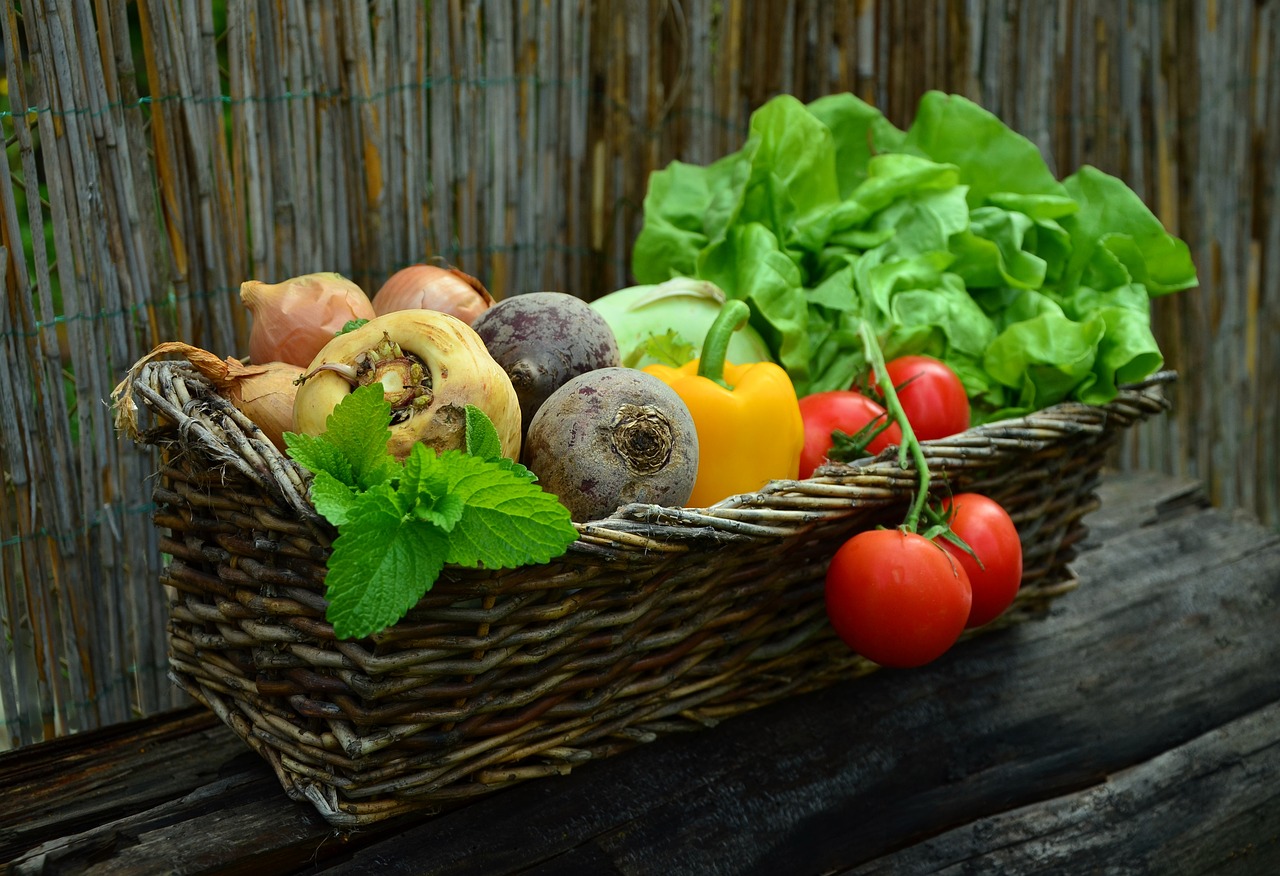
Understanding Pet Food Labels
When it comes to choosing the right food for your furry companion, understanding pet food labels is absolutely crucial. These labels are like a treasure map, guiding you through the often confusing world of pet nutrition. They contain vital information that can significantly influence your purchasing decisions. But wait, don't just grab the first bag that catches your eye! You need to familiarize yourself with the terminology used on these labels to truly decipher what’s inside your pet's food. Think of it like reading a book; if you don’t know the vocabulary, you might miss the plot!
First off, let’s talk about the ingredient list. This is typically the first thing you should look at. Ingredients are listed in descending order by weight, meaning the first few items are the most significant. If you see a vague term like "meat" or "animal by-products" listed at the top, it might raise a red flag. You want to see specific sources of protein, such as "chicken" or "salmon," because these are more reliable indicators of quality.
Next, you’ll notice the guaranteed analysis section, which provides a breakdown of the nutritional content. This includes percentages of protein, fat, fiber, and moisture. While it’s great to see high protein content, you should also consider the source of that protein. A food might boast high protein levels, but if it's primarily from low-quality fillers, it won't be as beneficial for your pet. Always look for a balance of nutrients that fits your pet's specific needs.
Another important aspect is the feeding guidelines. These are typically found on the back of the package and provide recommendations on how much to feed your pet based on their weight and age. However, remember that these are just guidelines. Every pet is different, and factors like activity level, health conditions, and metabolism can affect how much food they actually need. So, don’t be afraid to adjust accordingly!
Lastly, keep an eye out for certifications and claims. Some products may have labels like “complete and balanced” or “formulated to meet AAFCO standards.” These certifications can offer some reassurance about the quality and nutritional adequacy of the food. However, always do your research and make sure you understand what these claims really mean. Just like in life, not everything that glitters is gold!
In summary, understanding pet food labels is an essential skill for any responsible pet owner. By familiarizing yourself with the terminology and components, you can make informed choices that will benefit your pet's health and happiness. So next time you're at the pet store, take a moment to examine those labels carefully. Your pet will thank you for it!

Key Ingredients to Look For
When it comes to choosing the right food for your furry friend, understanding the key ingredients is essential. Just like humans, pets need a balanced diet to thrive, and not all pet foods are created equal. So, what should you be looking for on those ingredient lists? First and foremost, you want to prioritize high-quality proteins, as these are the building blocks of your pet’s diet. Look for specific animal sources like chicken, beef, or fish, rather than generic terms like “meat by-products.” The more specific, the better, as it indicates that the food contains real, identifiable protein sources.
In addition to proteins, you should also consider healthy fats. Fats are crucial for energy and help maintain a shiny coat. Look for sources like chicken fat or fish oil, which are rich in omega fatty acids. These fats not only provide energy but also support skin and coat health. Remember, not all fats are bad; in fact, they are essential to your pet's overall well-being!
Next on the list are carbohydrates. While some pet owners may be wary of carbs, they can be a valuable source of energy for your pet. Focus on whole grains like brown rice or oats, which are easier to digest than fillers like corn or wheat. If your pet has grain sensitivities, consider options that utilize vegetable-based carbohydrates, such as sweet potatoes or peas. These alternatives can offer the same energy benefits without the potential side effects.
Don't forget about fruits and vegetables! These ingredients are packed with essential vitamins, minerals, and antioxidants that can boost your pet's immune system. Look for ingredients like blueberries, carrots, or spinach in the list. Not only do they provide nutritional benefits, but they also add flavor and variety to your pet's meals. Just like you enjoy a colorful plate, your pet will appreciate a mix of flavors and textures as well!
Lastly, it's important to be aware of additives and preservatives. While some preservatives are necessary to keep food fresh, others can be harmful. Try to choose foods that use natural preservatives like tocopherols (vitamin E) instead of artificial ones. Always check for any chemical-sounding names that you can’t pronounce; if it sounds like it belongs in a science lab rather than in your pet’s bowl, it might be worth avoiding.
In summary, when reading ingredient lists, keep an eye out for:
- High-quality proteins from specific animal sources
- Healthy fats, like fish oil or chicken fat
- Whole grains or vegetable-based carbohydrates
- Fruits and vegetables for added nutrients
- Natural preservatives instead of artificial ones
By focusing on these key ingredients, you can make informed choices that will greatly benefit your pet’s health and happiness. After all, a well-fed pet is a happy pet!
Q: How can I tell if a pet food is high-quality?
A: Look for specific, identifiable ingredients, especially high-quality proteins, healthy fats, and whole grains. Avoid foods with vague terms like "meat by-products" and artificial preservatives.
Q: Are grain-free diets better for my pet?
A: Not necessarily. Grain-free diets can be beneficial for pets with specific allergies or sensitivities. However, many pets can digest whole grains without issues. It's best to consult with your veterinarian.
Q: What should I do if my pet has food allergies?
A: If you suspect food allergies, consult your veterinarian for a proper diagnosis. They may recommend an elimination diet or suggest hypoallergenic food options.
Q: Can I trust pet food marketing claims?
A: Be cautious! Many claims can be misleading. Always read the ingredient list and look for transparency in the ingredients used.
Proteins and Their Sources
When it comes to your pet's diet, proteins are the building blocks that support growth, energy, and overall health. Just like us, pets need a balanced intake of proteins to thrive. But not all proteins are created equal, and understanding the sources of these proteins is key to making informed decisions about your furry friend's food. So, what should you be looking for?
First, let's talk about animal proteins. These are derived from meat, fish, and poultry, and they provide essential amino acids that are crucial for your pet's well-being. Animal proteins are highly digestible and typically contain a complete amino acid profile, which is vital for muscle development and maintenance. When scanning ingredient lists, look for specific sources like chicken, beef, or fish. A label that states "chicken meal" or "salmon" is a good sign that your pet is getting quality protein.
On the flip side, we have plant proteins, which come from sources like peas, lentils, and soy. While these can contribute to your pet's protein intake, they often lack some essential amino acids that animal proteins provide. However, they can still be beneficial, especially for pets with specific dietary needs or allergies. It’s always a good idea to ensure that any plant proteins included in your pet's food are complemented with animal proteins to create a balanced diet.
To make it easier to understand the different protein sources, here's a quick comparison:
| Protein Source | Amino Acid Profile | Digestibility |
|---|---|---|
| Animal Proteins (e.g., chicken, beef) | Complete | High |
| Plant Proteins (e.g., peas, lentils) | Incomplete | Moderate |
Understanding the quality of these protein sources is equally important. Look for terms like "real meat" or "meat meal" on the label. Meat meal is particularly valuable because it contains rendered meat that is concentrated and stripped of moisture, making it a dense source of protein. However, be cautious of vague terms like "meat by-products," as these can include lower-quality ingredients that may not provide the nutrients your pet needs.
In conclusion, choosing the right protein sources is essential for your pet's health. Always prioritize high-quality animal proteins, but don’t completely dismiss plant proteins if they are part of a balanced diet. Remember, the goal is to provide your pet with a wide range of nutrients, and understanding protein sources is a significant step in achieving that.
- What are the best protein sources for dogs? High-quality animal proteins like chicken, beef, and fish are excellent choices.
- Can pets thrive on a vegetarian diet? While some pets can adapt to a vegetarian diet, it's crucial to ensure they receive all essential amino acids, usually found in animal proteins.
- How can I tell if my pet's food has high-quality protein? Look for specific animal protein sources listed at the top of the ingredient list and avoid vague terms like "meat by-products."
Animal vs. Plant Proteins
When it comes to choosing the right protein source for your furry friend, the debate between animal and plant proteins is a hot topic among pet owners and nutritionists alike. Animal proteins are derived from meat, fish, and poultry, while plant proteins come from sources like peas, lentils, and grains. But what does this really mean for your pet's health? Let’s break it down.
Animal proteins are generally considered high-quality because they provide all the essential amino acids that your pet needs for growth and energy. Think of animal proteins as the complete meal deal, packed with nutrients that are easily absorbed by your pet's body. For example, chicken, beef, and fish not only supply protein but also offer other valuable nutrients like omega-3 fatty acids, which are fantastic for skin and coat health. On the other hand, plant proteins can be beneficial as well, especially if they are combined to create a complete amino acid profile. However, they often lack certain essential amino acids that are crucial for your pet's overall health.
Here’s a quick comparison to help you visualize the differences:
| Aspect | Animal Proteins | Plant Proteins |
|---|---|---|
| Amino Acid Profile | Complete with essential amino acids | Often incomplete, may require combinations |
| Nutrient Absorption | Easily absorbed by pets | May require more processing for absorption |
| Digestibility | Generally high | Varies widely |
| Source | Meat, fish, poultry | Peas, lentils, grains |
While animal proteins have the edge in terms of digestibility and amino acid completeness, it’s essential to consider your pet’s specific dietary needs. For instance, some pets may have allergies or intolerances to certain animal proteins, making plant proteins a necessary alternative. Additionally, a balanced diet can include both animal and plant proteins, ensuring your pet gets a variety of nutrients.
Ultimately, the key is to look for high-quality sources of protein in your pet food. Whether you choose animal or plant proteins, make sure they are listed among the first few ingredients on the label. This indicates that they are the primary components of the food, ensuring your pet receives the nutrition they need to thrive.
- Can my pet survive on a plant-based diet? - While some pets can thrive on a well-balanced plant-based diet, it's crucial to consult with a veterinarian to ensure all nutritional needs are met.
- What are the signs my pet may be allergic to animal protein? - Look for symptoms like itching, gastrointestinal upset, or skin issues. If you suspect an allergy, consult your vet.
- How can I ensure my pet gets enough protein? - Choose high-quality pet food with clearly labeled protein sources and consult your veterinarian for personalized dietary advice.
Quality of Protein Sources
When it comes to your pet's diet, the is paramount. After all, protein is not just a filler; it’s the building block of your pet's body. Just like how we wouldn’t settle for low-quality ingredients in our meals, our furry friends deserve the best! But how do you determine what constitutes high-quality protein in pet food? Let's dive into this important topic.
First, it's essential to recognize that not all protein sources are created equal. High-quality proteins come from identifiable animal sources, such as chicken, beef, or fish. These proteins are not only more digestible for your pet but also provide essential amino acids that are crucial for their overall health. In contrast, lower-quality proteins might come from by-products or unnamed meat sources, which can be less beneficial and harder for your pet to digest.
To make informed decisions, consider the following factors when evaluating protein quality:
- Source Identification: Look for specific names of animal proteins. For example, "chicken meal" is preferable to "meat meal," as it indicates a specific source.
- Protein Digestibility: High-quality proteins are more easily absorbed by your pet's body. This means that your pet will get more nutritional value from their food.
- Amino Acid Profile: Ensure that the protein source provides a complete amino acid profile. Essential amino acids are vital for your pet's growth and maintenance.
Moreover, you should also be aware of the protein content listed on the label. A high protein percentage can be enticing, but it’s crucial to ensure that the proteins are of high quality. Sometimes, manufacturers may inflate protein levels by including lower-quality fillers that do not provide the same nutritional benefits. Thus, always look beyond the numbers!
In addition, consider the process of sourcing. High-quality brands often transparently share where their ingredients come from. If a company is proud of their sourcing practices, they will likely provide that information on their packaging or website. This transparency can be a good indicator of quality and care in the production of your pet’s food.
Ultimately, the goal is to provide your pet with a balanced diet that supports their health and vitality. Understanding the quality of protein sources in their food is a significant step in achieving that. By choosing high-quality proteins, you’re not just feeding your pet; you’re investing in their long-term health and happiness.
Q1: How can I tell if a protein source is of high quality?
A1: Look for specific animal names in the ingredient list, such as "chicken" or "beef," rather than vague terms like "meat" or "animal by-products." Also, check for the protein digestibility and amino acid profile.
Q2: Are plant proteins a good option for pets?
A2: While some pets can benefit from plant proteins, they are generally not as complete as animal proteins. It’s essential to ensure that your pet’s diet includes high-quality animal proteins for optimal health.
Q3: Does a higher protein percentage always mean better quality?
A3: Not necessarily. A high protein percentage can sometimes be achieved by including low-quality fillers. Always consider the source and digestibility of the protein rather than just the percentage.
Q4: How important is protein in my pet's diet?
A4: Protein is crucial for your pet's growth, energy, and overall well-being. It supports muscle development, immune function, and various metabolic processes.
Understanding Additives and Preservatives
When it comes to pet food, additives and preservatives are often hot topics of discussion. These ingredients are included for various reasons, and understanding their roles can significantly influence your purchasing decisions. First off, let's clarify what these terms mean. Additives are substances added to pet food to enhance its flavor, texture, or nutritional value. On the other hand, preservatives are used to extend the shelf life of the product, preventing spoilage and maintaining freshness.
Not all additives and preservatives are created equal, though. Some can be beneficial, while others may raise red flags. For instance, natural preservatives like tocopherols (vitamin E) and ascorbic acid (vitamin C) are generally considered safe and can even provide health benefits. In contrast, synthetic preservatives such as BHA, BHT, and ethoxyquin have been linked to potential health risks. It’s crucial to keep an eye out for these ingredients when reviewing your pet's food label.
Here’s a quick breakdown of some common additives and preservatives you might encounter:
- Flavor Enhancers: Ingredients like chicken fat or beef broth can make the food more palatable for picky eaters.
- Nutritional Additives: Vitamins and minerals are often added to ensure a balanced diet, but it's essential to check their sources.
- Preservatives: As mentioned earlier, natural preservatives are preferable, while synthetic ones should be approached with caution.
Understanding the purpose of these ingredients can help you make more informed choices. For instance, if you notice a long list of unrecognizable synthetic additives, it might be a sign of lower-quality food. On the flip side, a product that lists whole foods and natural preservatives is often a better choice for your furry friend.
In addition to knowing what to look for, it’s important to understand how these ingredients interact with your pet's overall health. Some pets may have sensitivities to certain additives, leading to digestive issues or allergic reactions. Therefore, always consult with your veterinarian if you’re unsure about the ingredients in your pet's food.
As you navigate the world of pet food, remember that knowledge is power. By understanding the role of additives and preservatives, you can confidently choose products that not only meet your pet's nutritional needs but also promote their overall health and well-being.
1. Are all additives harmful to my pet?
No, not all additives are harmful. Many are used to enhance flavor or nutrition, while some can be beneficial. Always check the ingredient list and consult your veterinarian if you have concerns.
2. What preservatives should I avoid?
Synthetic preservatives like BHA, BHT, and ethoxyquin are generally considered less safe than natural options. Look for products that use natural preservatives like vitamin E or C.
3. How can I tell if a pet food is high quality?
Look for clear labeling with recognizable ingredients, minimal synthetic additives, and a good balance of protein, fats, and carbohydrates. Research the brand's reputation and consult your vet for recommendations.
4. Can additives affect my pet's behavior?
Yes, some additives may cause allergies or sensitivities in pets, potentially leading to behavioral changes. If you notice unusual behavior after changing your pet's food, consult your veterinarian.

Common Misleading Terms
When it comes to pet food, the packaging can sometimes be a minefield of misleading terms that leave pet owners scratching their heads. It's essential to cut through the marketing fluff and understand what these terms really mean, as they can significantly influence your purchasing decisions. For instance, the word "natural" is often thrown around like confetti at a parade, but what does it actually signify? In the pet food industry, "natural" typically refers to ingredients that are minimally processed and free from synthetic additives. However, this term is not strictly regulated, meaning that a product could still contain fillers or low-quality ingredients and be labeled as natural.
Another term that often causes confusion is "organic." While organic ingredients must meet specific standards set by regulatory bodies, the term is often misused. For example, a pet food labeled as organic must contain a minimum of 95% organic ingredients, but this doesn't guarantee that the remaining 5% is high-quality. So, while your furry friend might be munching on "organic chicken," it’s crucial to check what else is in the mix.
Additionally, the term "grain-free" has gained popularity, especially among pet owners who believe it to be a healthier option. However, it's important to note that not all pets require a grain-free diet. In fact, grains can provide essential nutrients and fiber. Some pets may even thrive on a diet that includes grains. So, before jumping on the grain-free bandwagon, consider your pet's specific needs and consult with your veterinarian.
To help clarify some of these misleading terms, here's a quick comparison:
| Term | Meaning | Considerations |
|---|---|---|
| Natural | Minimally processed ingredients | Not strictly regulated; may still contain fillers |
| Organic | Ingredients grown without synthetic fertilizers or pesticides | Must contain at least 95% organic ingredients; remaining 5% may vary |
| Grain-Free | Excludes grains from the ingredient list | Not necessary for all pets; may lack essential nutrients |
In summary, understanding these common terms is vital for making informed decisions about your pet's diet. Always remember to look beyond the label and investigate the actual ingredients. Knowing the difference can help you choose the best food for your beloved companion, ensuring they receive the nutrition they truly deserve.
- What should I look for in a pet food label? Look for high-quality protein sources, whole ingredients, and minimal fillers.
- Are grain-free diets safe for all pets? Not necessarily. Consult with your veterinarian to determine the best diet for your pet.
- What does "by-product" mean in pet food? By-products are secondary products derived from the processing of meat; their quality can vary greatly.
- Can I trust the "natural" label on pet food? Be cautious; "natural" is not strictly regulated and can still include low-quality ingredients.
Natural vs. Organic
When it comes to choosing the best food for your pet, the terms natural and organic often pop up, leaving many pet owners scratching their heads. What do these labels really mean, and how do they impact your furry friend's diet? Understanding the difference between these two terms is crucial for making informed decisions about your pet’s nutrition.
The term natural typically refers to ingredients that are derived from nature and do not contain artificial flavors, colors, or preservatives. However, this label can be somewhat misleading. For instance, a food labeled as "natural" might still contain by-products or fillers that aren't necessarily beneficial for your pet's health. It's important to read the ingredient list thoroughly, as the term "natural" does not guarantee high-quality ingredients.
On the other hand, organic foods must meet specific standards set by the USDA. This means that the ingredients are grown without the use of synthetic fertilizers, pesticides, or genetically modified organisms (GMOs). Organic pet food is often considered a healthier option, as it tends to be free from harmful chemicals and additives. However, it’s worth noting that just because a food is organic doesn’t automatically make it the best choice for your pet.
To illustrate the differences more clearly, consider the following table:
| Feature | Natural | Organic |
|---|---|---|
| Definition | Derived from nature, no artificial ingredients | Meets USDA standards, no synthetic chemicals |
| Ingredient Quality | Can include by-products and fillers | Higher quality, often whole ingredients |
| Certification | No official certification required | Must be certified organic by the USDA |
| Price | Generally lower cost | Typically more expensive |
In summary, while both natural and organic pet foods have their merits, it's essential to dig deeper than the labels. Always check the ingredient list and research the brand to ensure you're providing your pet with the best nutrition possible. Remember, just because a product claims to be natural doesn't mean it’s the healthiest option available. So, when shopping for pet food, consider not just the label, but also the quality and source of the ingredients.
- What is the main difference between natural and organic pet food? Natural pet food contains ingredients derived from nature without artificial additives, while organic pet food meets specific USDA standards and is free from synthetic chemicals.
- Is organic pet food worth the higher price? Many pet owners believe that the health benefits of organic ingredients justify the cost, but it ultimately depends on your pet's specific dietary needs.
- Can natural pet food still be unhealthy? Yes, some natural pet foods may contain low-quality ingredients or fillers, so it's important to read the ingredient list carefully.
- How can I ensure I'm choosing the best food for my pet? Look for high-quality ingredients, understand the labels, and consult your veterinarian for personalized recommendations.
Understanding pet food ingredient lists is crucial for making informed choices about your pet's nutrition. This article will guide you through key components, terminology, and tips for selecting the best food for your furry friend.
Pet food labels contain essential information that can influence your purchasing decisions. Familiarizing yourself with label terminology will help you decipher what’s truly in your pet's food.
Identifying high-quality ingredients is vital for your pet's health. This section will highlight the most beneficial components and what to prioritize when selecting pet food.
Proteins are essential for your pet's growth and energy. Understanding the different protein sources can help you choose the best options for your pet's dietary needs.
Not all proteins are created equal. This part will explore the differences between animal and plant-based proteins and their impact on your pet's health.
The quality of protein sources matters significantly. We'll discuss how to identify high-quality protein ingredients and why they are crucial for your pet's diet.
Additives and preservatives can play a role in pet food longevity and nutritional value. This section will clarify which additives are beneficial and which to avoid.
Many pet food labels use marketing jargon that can be misleading. Here, we’ll break down common terms that may confuse pet owners and clarify their meanings.
Understanding the difference between and organic can help you make better choices. When you see the term on a pet food label, it often implies that the ingredients are derived from sources that are minimally processed and do not contain artificial flavors, colors, or preservatives. However, this term can be somewhat ambiguous and is not strictly regulated, which means that it can vary significantly between brands.
For example, a product labeled as might still include some ingredients that are processed to a certain extent. It’s essential to look beyond the label and examine the ingredient list. Here are a few things to keep in mind:
- Whole Ingredients: Look for whole foods like real meat, vegetables, and grains.
- No Artificial Additives: Ensure there are no synthetic preservatives or dyes.
- Transparency: Brands that are genuinely committed to natural ingredients often provide detailed information about their sourcing and processing methods.
While natural ingredients can be beneficial, they do not always guarantee a complete and balanced diet. It's vital to ensure that the food meets the nutritional needs of your pet, which can sometimes require a bit more research.
Grain-free diets are popular, but they aren't always the best choice for every pet. This section will discuss the potential benefits and drawbacks of grain-free pet food options.
Sometimes, the ingredient list can tell you more than the marketing claims. Learn how to analyze ingredient placement and what it means for your pet's food quality.
With the right knowledge, you can confidently choose the best food for your pet. This final section will provide tips for making informed decisions based on ingredient lists and labels.
Q: What does 'natural' mean on pet food labels?
A: 'Natural' typically refers to ingredients that are minimally processed and free from artificial additives. However, this term can be vague, so it's essential to check the ingredient list for quality.
Q: Are grain-free diets better for my pet?
A: Grain-free diets can be beneficial for some pets, particularly those with grain sensitivities. However, they may not be necessary for all pets, and it's best to consult with a veterinarian.
Q: How can I tell if a pet food is high quality?
A: Look for whole ingredients, a clear source of protein, and minimal artificial additives. Researching the brand's reputation can also provide insight into their quality.
Understanding pet food ingredient lists is crucial for making informed choices about your pet's nutrition. This article will guide you through key components, terminology, and tips for selecting the best food for your furry friend.
Pet food labels contain essential information that can influence your purchasing decisions. Familiarizing yourself with label terminology will help you decipher what’s truly in your pet's food.
Identifying high-quality ingredients is vital for your pet's health. This section will highlight the most beneficial components and what to prioritize when selecting pet food.
Proteins are essential for your pet's growth and energy. Understanding the different protein sources can help you choose the best options for your pet's dietary needs.
Not all proteins are created equal. This part will explore the differences between animal and plant-based proteins and their impact on your pet's health.
The quality of protein sources matters significantly. We'll discuss how to identify high-quality protein ingredients and why they are crucial for your pet's diet.
Additives and preservatives can play a role in pet food longevity and nutritional value. This section will clarify which additives are beneficial and which to avoid.
Many pet food labels use marketing jargon that can be misleading. Here, we’ll break down common terms that may confuse pet owners and clarify their meanings.
Understanding the difference between natural and organic can help you make better choices. This subheading will explain these terms and their implications for pet food.
Grain-free diets are popular, but they aren't always the best choice for every pet. This section will discuss the potential benefits and drawbacks of grain-free pet food options.
Sometimes, the ingredient list can tell you more than the marketing claims. Learn how to analyze ingredient placement and what it means for your pet's food quality.
With the right knowledge, you can confidently choose the best food for your pet. This final section will provide tips for making informed decisions based on ingredient lists and labels.
- What should I look for first on a pet food label? Start with the protein source; it should be the first ingredient listed.
- Are all grains bad for pets? Not necessarily; some pets can benefit from grains, while others may have sensitivities.
- What does 'by-product' mean in pet food? By-products are secondary products derived from the main ingredient, which can vary in quality.
- How can I tell if a pet food is high quality? Look for named meat sources, whole ingredients, and minimal fillers or artificial additives.
- Is it necessary to choose organic pet food? While organic can be beneficial, it's not a requirement; focus on overall ingredient quality.
Understanding pet food ingredient lists is crucial for making informed choices about your pet's nutrition. This article will guide you through key components, terminology, and tips for selecting the best food for your furry friend.
Pet food labels contain essential information that can influence your purchasing decisions. Familiarizing yourself with label terminology will help you decipher what’s truly in your pet's food.
Identifying high-quality ingredients is vital for your pet's health. This section will highlight the most beneficial components and what to prioritize when selecting pet food.
Proteins are essential for your pet's growth and energy. Understanding the different protein sources can help you choose the best options for your pet's dietary needs.
Not all proteins are created equal. This part will explore the differences between animal and plant-based proteins and their impact on your pet's health.
The quality of protein sources matters significantly. We'll discuss how to identify high-quality protein ingredients and why they are crucial for your pet's diet.
Additives and preservatives can play a role in pet food longevity and nutritional value. This section will clarify which additives are beneficial and which to avoid.
Many pet food labels use marketing jargon that can be misleading. Here, we’ll break down common terms that may confuse pet owners and clarify their meanings.
Understanding the difference between natural and can help you make better choices. The term "natural" often refers to ingredients that are minimally processed and free from artificial additives, while "organic" denotes a higher standard of quality. Organic pet food must meet specific regulations, ensuring that the ingredients are grown without the use of synthetic fertilizers, pesticides, or genetically modified organisms (GMOs).
When you see the label on pet food, it signifies that the ingredients are sourced from farms that adhere to strict guidelines. This means your pet is consuming food made from ingredients that are not only healthier for them but also better for the environment. However, it's essential to note that just because a product is labeled organic does not automatically make it the best option for your pet. Always check the ingredient list and nutritional information.
Here’s a quick comparison:
| Aspect | Natural | Organic |
|---|---|---|
| Definition | Minimally processed, no artificial additives | Produced without synthetic fertilizers or pesticides |
| Regulations | Less regulated | Strict USDA regulations apply |
| Health Benefits | May contain some healthy ingredients | Generally healthier, environmentally friendly |
In summary, while both terms are appealing, holds a more stringent definition and often implies a higher quality of ingredients. It’s essential to remember that your pet’s dietary needs should always dictate your choice, so take the time to read labels carefully.
Grain-free diets are popular, but they aren't always the best choice for every pet. This section will discuss the potential benefits and drawbacks of grain-free pet food options.
Sometimes, the ingredient list can tell you more than the marketing claims. Learn how to analyze ingredient placement and what it means for your pet's food quality.
With the right knowledge, you can confidently choose the best food for your pet. This final section will provide tips for making informed decisions based on ingredient lists and labels.
- What should I look for in the ingredient list? Focus on high-quality protein sources, whole grains, and avoid artificial additives.
- Is organic pet food better for my pet? It can be, as it often contains fewer chemicals and additives, but always check the specific ingredients.
- Are grain-free diets suitable for all pets? Not necessarily; consult your veterinarian to determine the best diet for your pet's needs.
Understanding pet food ingredient lists is crucial for making informed choices about your pet's nutrition. This article will guide you through key components, terminology, and tips for selecting the best food for your furry friend.
Pet food labels contain essential information that can influence your purchasing decisions. Familiarizing yourself with label terminology will help you decipher what’s truly in your pet's food.
Identifying high-quality ingredients is vital for your pet's health. This section will highlight the most beneficial components and what to prioritize when selecting pet food.
Proteins are essential for your pet's growth and energy. Understanding the different protein sources can help you choose the best options for your pet's dietary needs.
Not all proteins are created equal. This part will explore the differences between animal and plant-based proteins and their impact on your pet's health.
The quality of protein sources matters significantly. We'll discuss how to identify high-quality protein ingredients and why they are crucial for your pet's diet.
Additives and preservatives can play a role in pet food longevity and nutritional value. This section will clarify which additives are beneficial and which to avoid.
Many pet food labels use marketing jargon that can be misleading. Here, we’ll break down common terms that may confuse pet owners and clarify their meanings.
Understanding the difference between natural and organic can help you make better choices. The term "natural" refers to ingredients that are derived from nature without artificial additives or preservatives. However, it doesn't guarantee the absence of pesticides or other harmful substances. On the other hand, "organic" indicates that the ingredients are grown without synthetic fertilizers or pesticides and meet specific regulatory standards. This distinction is important because it can affect your pet's health and well-being. When selecting pet food, consider looking for labels that specify organic ingredients if you are concerned about chemical exposure.
Grain-free diets are popular, but they aren't always the best choice for every pet. This section will discuss the potential benefits and drawbacks of grain-free pet food options.
Sometimes, the ingredient list can tell you more than the marketing claims. Learn how to analyze ingredient placement and what it means for your pet's food quality.
With the right knowledge, you can confidently choose the best food for your pet. This final section will provide tips for making informed decisions based on ingredient lists and labels.
- What does it mean if a pet food is labeled as 'natural'? - It means that the ingredients are derived from nature, but it doesn't guarantee they are free from harmful chemicals.
- Are grain-free diets better for my pet? - Not necessarily. While some pets may benefit from a grain-free diet, others may require grains for balanced nutrition.
- How can I tell if the protein source is high-quality? - Look for named animal protein sources (like chicken or beef) at the top of the ingredient list, and avoid vague terms like 'meat by-products.'
Grain-Free and Its Implications
When it comes to pet food, the term grain-free has gained significant traction among pet owners. Many believe that removing grains from their pets' diets is synonymous with better health. However, this assumption isn't as straightforward as it seems. While some pets may indeed benefit from a grain-free diet, it's essential to understand the implications and potential consequences of such a choice.
First off, let’s clarify what we mean by grain-free. This type of diet eliminates traditional grains like wheat, corn, and rice, replacing them with alternative carbohydrate sources such as potatoes, peas, or lentils. For some pets, particularly those with specific allergies or sensitivities, this can lead to improved digestion and overall well-being. However, it's crucial to remember that not all pets are the same. Just like humans, our furry friends have unique dietary needs.
The popularity of grain-free diets has also sparked significant debate among veterinarians and pet nutritionists. Some experts argue that grains can be a healthy part of a pet's diet, providing essential nutrients and fiber. In fact, grains are often a source of protein and can contribute to a balanced diet. Here are some considerations to keep in mind if you're contemplating a grain-free diet for your pet:
- Allergies and Sensitivities: If your pet has shown signs of food allergies, such as itching or gastrointestinal upset, a grain-free diet might be worth exploring.
- Quality of Ingredients: Just because a food is grain-free doesn’t mean it’s high quality. Always check the ingredient list for real meat sources and avoid fillers.
- Potential Health Risks: Some studies have suggested a link between grain-free diets and certain health issues, including dilated cardiomyopathy (DCM) in dogs. It’s essential to consult with your veterinarian before making any drastic changes.
In conclusion, while grain-free diets can be beneficial for some pets, they aren't a one-size-fits-all solution. Always consider your pet's unique health needs and consult with a veterinarian to determine the best dietary approach. Remember, the goal is to provide a balanced diet that supports your pet's health and happiness!
Here are some common questions pet owners have about grain-free diets:
- Is a grain-free diet necessary for all pets? No, not all pets require a grain-free diet. It's essential to evaluate your pet's specific health needs.
- What are the benefits of grains in pet food? Grains can provide essential nutrients, fiber, and energy, contributing to a balanced diet.
- Should I consult my vet before switching to grain-free? Absolutely! Your veterinarian can help determine the best diet for your pet's individual health needs.

Reading Between the Lines
When it comes to pet food, the ingredient list can often reveal more than the flashy marketing claims on the front of the package. Just like a good book, you need to dig a little deeper to uncover the true story behind what you’re feeding your furry friend. The placement of ingredients, the specific terms used, and even the order in which they appear can provide critical insights into the quality and nutritional value of the food.
The ingredient list is typically arranged in descending order by weight. This means that the first few ingredients are the most significant. If you see a high-quality protein source, such as chicken or beef, listed at the top, that’s a good sign. However, if you notice a vague term like "meat by-products" or "animal digest" leading the list, it might be time to reconsider your choice. Just like you wouldn’t want to eat mystery meat, your pet deserves better!
It’s also essential to be aware of the presence of fillers and artificial additives. These ingredients often serve little nutritional purpose and can be detrimental to your pet’s health. Common fillers include:
- Corn
- Wheat
- Soy
These fillers can cause allergies or digestive issues in some pets. Instead, look for wholesome ingredients that provide real benefits, like sweet potatoes, peas, or brown rice. These not only add fiber but also essential vitamins and minerals.
Another important aspect to consider is the use of specific terms. For example, "fresh" or "whole" can be appealing but may not always mean what you think. Fresh ingredients can lose nutrients during processing, and "whole" doesn’t always guarantee quality. It’s crucial to look beyond the buzzwords and focus on the actual ingredients. Understanding these nuances can empower you as a pet owner to make better decisions for your pet's health.
Lastly, don't forget to check for any potential allergens or ingredients your pet may be sensitive to. If your pet has a known allergy, be vigilant about reading every ingredient. It’s like being a detective—every detail counts!
In conclusion, learning to read between the lines of pet food labels is an invaluable skill. By paying attention to ingredient placement, understanding terminology, and being aware of fillers and allergens, you can ensure that your pet receives the best possible nutrition. Remember, the more informed you are, the healthier your furry friend will be!
Q: What should I look for first on a pet food label?
A: Start with the first few ingredients. High-quality protein sources should be at the top of the list.
Q: Are fillers really that bad for my pet?
A: Yes, fillers like corn and soy provide little nutritional value and can lead to allergies or digestive issues.
Q: What do terms like "natural" and "organic" really mean?
A: "Natural" means that the food contains no artificial ingredients, while "organic" refers to ingredients grown without synthetic fertilizers or pesticides.
Q: How can I tell if a protein source is high-quality?
A: Look for specific animal names (like chicken or beef) rather than generic terms (like "meat" or "animal products").
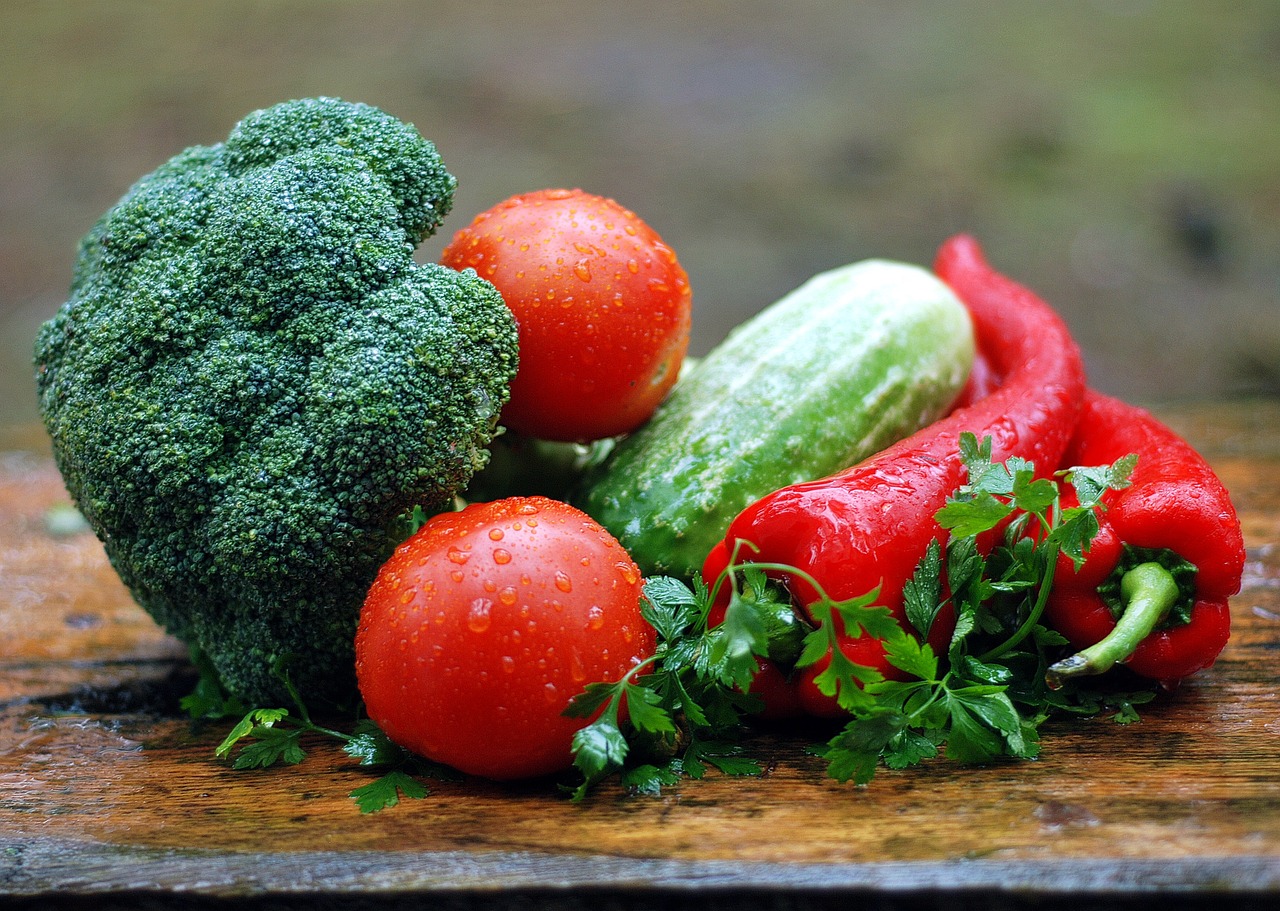
Making Informed Choices
Choosing the right food for your furry friend can feel like navigating a maze, especially with all the different brands and marketing claims out there. But don't worry! By understanding the ingredient lists and labels, you can make informed choices that will benefit your pet's health and happiness. First, always remember that the ingredient list is your best friend. It's like a treasure map that leads you to the nutritional gold your pet needs. Start by looking for a high-quality protein source as the first ingredient. This is crucial because a protein-rich diet is essential for your pet's growth, energy, and overall well-being.
Next, be cautious of vague terms like "meat by-products" or "animal fat." These can often be lower-quality ingredients that you should avoid. Instead, opt for specific sources like "chicken meal" or "salmon." These indicate a higher quality of meat that is more beneficial for your pet. Additionally, understanding the role of carbohydrates is important. While some carbs are necessary for energy, too many can lead to obesity and other health issues. Look for whole grains or vegetables that provide fiber and nutrients without excessive calories.
When it comes to additives and preservatives, knowledge is power. Some additives, like probiotics, can be beneficial for your pet's digestive health, while others, like artificial colors and flavors, should be avoided. Always check for natural preservatives like tocopherols (Vitamin E) instead of synthetic ones. A good rule of thumb is to choose foods with minimal processing and recognizable ingredients. If you can't pronounce it, it's probably best left on the shelf.
Lastly, don't forget about your pet's specific needs. Every pet is unique, and their dietary requirements can vary based on age, breed, and health conditions. For instance, puppies require more protein and fat than adult dogs, while senior pets might benefit from lower calories and joint support supplements. Don't hesitate to consult with your veterinarian to tailor your pet's diet accordingly.
In conclusion, making informed choices about your pet's food is a combination of understanding ingredient lists, recognizing quality sources, and considering your pet's individual needs. By taking the time to read labels and educate yourself on what goes into your pet's food, you can ensure that you are providing them with the best nutrition possible. Remember, a well-fed pet is a happy pet!
- What should I look for first on a pet food label? Always check for a high-quality protein source as the first ingredient.
- Are all additives harmful? Not all additives are bad; some, like probiotics, can be beneficial. Avoid artificial colors and flavors.
- How can I tell if a protein source is high quality? Look for specific names like "chicken meal" instead of vague terms like "meat by-products."
- Should I consult my vet about my pet's diet? Yes, consulting your veterinarian can help you make the best dietary choices based on your pet's unique needs.
Frequently Asked Questions
- What should I look for first on a pet food label?
When you glance at a pet food label, the first thing you want to check is the ingredient list. Look for high-quality protein sources at the top. Ingredients are listed in descending order by weight, so the first few items are crucial for understanding what your pet is actually eating.
- Are animal proteins better than plant proteins?
Generally speaking, animal proteins are considered superior for pets because they provide essential amino acids that are vital for growth and energy. However, some plant proteins can also be beneficial, especially when combined properly. It’s all about balance!
- What does 'natural' mean on pet food labels?
The term 'natural' can be a bit fuzzy. It typically means that the ingredients are derived from natural sources without artificial additives. However, it’s important to note that 'natural' doesn’t always equate to 'high-quality.' Always read the ingredient list to get the full picture.
- Is grain-free food better for my pet?
Grain-free diets have gained popularity, but they aren't necessarily better for every pet. Some pets may benefit from grains, while others may have sensitivities. It's essential to consult your vet to determine what's best for your furry friend.
- How do I know if a protein source is high-quality?
A high-quality protein source is usually specified by its type, such as 'chicken' or 'beef,' rather than vague terms like 'meat meal.' Look for whole meats or named meat meals as the first ingredient for the best quality.
- What are some common additives to avoid?
Some additives, like artificial colors, flavors, and preservatives (like BHA and BHT), can be harmful to your pet's health. Instead, look for natural preservatives like tocopherols (vitamin E) or ascorbic acid (vitamin C) that can keep the food fresh without negative effects.
- Can I trust the claims made on pet food packages?
Not always! Pet food manufacturers often use marketing jargon that can be misleading. Always dive deeper into the ingredient list and nutritional information to understand what’s really in the food.
- How can I make informed decisions about my pet's food?
Start by educating yourself on ingredient lists and nutritional needs. Consult with your vet for personalized recommendations, and don’t hesitate to ask questions when shopping for pet food. Knowledge is power!

